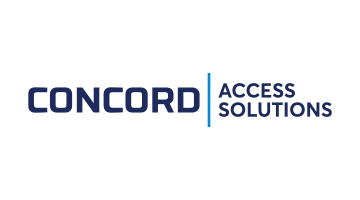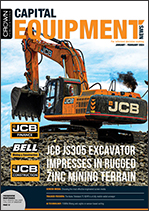 COVER STORY: In the demanding terrain of zinc mines in the Aggeneys area of the Northern Cape, Lapua (Pty) Ltd, a hydraulic repair and maintenance specialist, found a reliable ally in the JCB JS305 Excavator. Facing the abrasive sphalerite rock known for its toughness on equipment, Lapua is impressed with its durability despite the challenging conditions.
COVER STORY: In the demanding terrain of zinc mines in the Aggeneys area of the Northern Cape, Lapua (Pty) Ltd, a hydraulic repair and maintenance specialist, found a reliable ally in the JCB JS305 Excavator. Facing the abrasive sphalerite rock known for its toughness on equipment, Lapua is impressed with its durability despite the challenging conditions.
Willem Wium believes he is loyal to a brand that looks after his business. He has found a certain yellow excavator that seems particularly hardy for working in challenging conditions.
A son of the Free State, Willem hails from the historic town of Philippolis in the west of the province. He worked in banking for 15 years before venturing into buying and selling livestock, a job he, by his own admission, really enjoyed.
"Life, however, moves one in different directions, and in about 2007, I found myself dabbling in hydraulics in the mining industry in Rustenburg," Wium tells us.
"I registered my company, Lapua (Pty) Ltd, in Rustenburg in 2011, which specialises in all aspects of hydraulic repair and maintenance in the mining industry, on surface and underground."
In 2016, he successfully tendered to do hydraulic maintenance on the zinc mines in the Aggeneys area of the Northern Cape, opening an opportunity to extend his services further afield.
His company's tasks included repairing and maintaining the hydraulics on drill rigs, trucks, and loaders used in underground and surface mining and all aspects of high-pressure hydraulic hoses and fittings. This was challenging as the service was required around the clock, 365 days a year.
PREVENTATIVE MAINTENANCE: When is a spare part, not just a spare part? The answer, says Pilot Crushtec Director Technical Support Jorge Abelho, is when it is designed and manufactured with the machine’s whole system in mind.
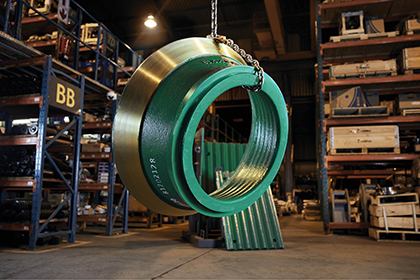 Abelho spoke to Capital Equipment News and explained that Pilot Crushtec customers use the company’s equipment to achieve the lowest cost of ownership while optimising their production and bottom line.
Abelho spoke to Capital Equipment News and explained that Pilot Crushtec customers use the company’s equipment to achieve the lowest cost of ownership while optimising their production and bottom line.
“The specific characteristics of our spare parts and components make this possible – and allow us to provide them with industry-beating standard warranties and uptime.”
From this starting point, he argues, it makes sense that Pilot Crushtec invests heavily in the quality and the breadth of its parts inventory. Unlike the aftermarket supplier, the Original Equipment Manufacturer (OEM) must consider the item of equipment as a whole. In this context, every spare part has an integral function for other aspects of each machine.
“We look at the bigger picture to ensure that every part or component of our equipment interacts optimally with the other parts,” he explains. We can do this because of our intricate knowledge of how the systems work and the continuous research and development we conduct to improve and fine-tune performance.”
An example of what this means for spare parts is that the OEM may decide to include a sacrificial part in the system to protect a more complex and expensive component. With this knowledge and experience, an aftermarket manufacturer will have these insights.
The part they produce, therefore, may miss this nuance and inadvertently lead to unexpected and costly results.
“The OEM must not only consider this kind of intricacy in the design and manufacture of its parts, but it must also ensure that all the parts a customer needs are available,” he says.
“In contrast, the aftermarket supplier will cherry-pick those fastmoving parts that sell most frequently and offer just a small selection of a customer’s needs.”
SCREEN MEDIA: Many mining and aggregates operations have used traditional products, such as woven wire cloth, for years with excellent results.
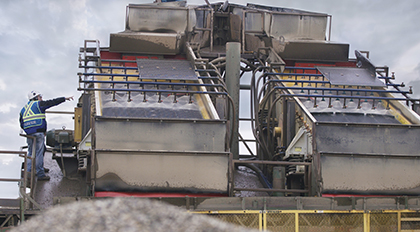 However, engineered screen media for operations experiencing high wear and frequent screen changeouts is worth looking into. Polyurethane, rubber, and perforated steel plates handle heavy and abrasive materials better than woven wire. But operators need to know how to choose the best screen media. The difference between using “good enough” screen media instead of the optimal screen media for the application can be unwanted downtime and expense.
However, engineered screen media for operations experiencing high wear and frequent screen changeouts is worth looking into. Polyurethane, rubber, and perforated steel plates handle heavy and abrasive materials better than woven wire. But operators need to know how to choose the best screen media. The difference between using “good enough” screen media instead of the optimal screen media for the application can be unwanted downtime and expense.
Consider three things when selecting the best-engineered screen media for an application.
Steve Fair, the Tyler-engineered media manager at Haver & Boecker Niagara, makes some starting suggestions. “First, look at all aspects of an aggregates or mining operation and any challenges to increasing production rates and profitability. Second, look at the composition of the material going through the vibrating screen and consult an expert from a reputable company to match the best screen media to the application. Finally, learn to install and maintain the screen media properly,” he says.
TRACKED FEEDERS: Ireland-based Astec Telestack has been part of the Astec Industries portfolio since it was acquired by the group in 2014.
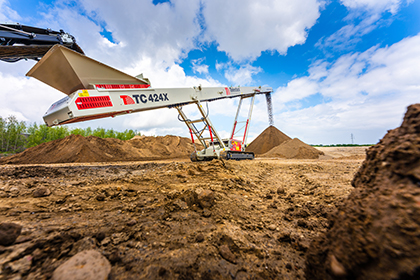 Astec Telestack equipment is improving the productivity in South African operations ranging from warehouses, rail yards and ports to mines, quarries and quarries, and the Astec Telestack HF 520 unit is proving to be a significant asset where it operates.
Astec Telestack equipment is improving the productivity in South African operations ranging from warehouses, rail yards and ports to mines, quarries and quarries, and the Astec Telestack HF 520 unit is proving to be a significant asset where it operates.
Astec regional product and sales manager Andre Kruger explains that a customer in the Northern Cape will use an Astec Telestack HF 520 unit in a load-out application. The HF 520 is a track-mounted, fully mobile conveyor.
Like all of the stacking equipment in Astec’s tracked hopper feeder range, it is designed to be loaded directly from wheel loaders, grab cranes, and excavators. This means that the same piece of equipment can be used to stockpile material, feed auxiliary equipment or fixed equipment, reclaim onto overland conveyors, load barges, vessels and rail wagons directly from wheel loaders, or grab cranes. Since the hopper feeder is track mounted, the unit has excellent mobility on site and will eliminate the need for Astec South Africa’s customer to double handle material, Kruger explains. This translates into reduced overall costs, he states.
“Our customer recognised this outstanding machine’s potential to lower operating and fuel costs by up to 50%. In today’s tough economic climate, these are substantial savings. But while offering cost savings, the HF 520 does not compromise on safety, quality, and performance. It is a high-spec machine designed for easy maintenance and maximum production,” says Kruger about the Telestack tracked hopper feeder.
NEW EQUIPMENT: A launch ceremony held at the company’s Jet Park premises in Johannesburg in December last year marked the culmination of its efforts to establish direct operations in South Africa. Sunward Group is one of the top 50 construction equipment manufacturers globally, ranking 37th in the KHL Yellow Table 2023.
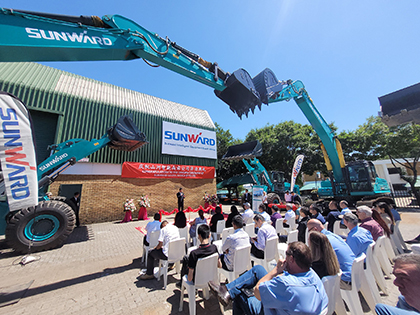 The company offers world-class piling machines, drilling rigs, aerial work platforms, skid-steer loaders, crawler and wheeled cranes, mobile crushing stations, and a complete range of excavators. The strategic move to establish direct operations in South Africa aims to enhance the company’s support and provide better service to local dealers and customers through a specialist team and spare parts stock. Sunward South Africa was registered as a subsidiary in January 2020. Despite the challenges posed by the pandemic, the company is now poised to enhance its brand image in the South African market.
The company offers world-class piling machines, drilling rigs, aerial work platforms, skid-steer loaders, crawler and wheeled cranes, mobile crushing stations, and a complete range of excavators. The strategic move to establish direct operations in South Africa aims to enhance the company’s support and provide better service to local dealers and customers through a specialist team and spare parts stock. Sunward South Africa was registered as a subsidiary in January 2020. Despite the challenges posed by the pandemic, the company is now poised to enhance its brand image in the South African market.
Sunward’s range of machines accessible to Africa’s mining sector includes a full range of down-the-hole, top hammer, and rotary-type drill rigs, excavators, loaders, dozers, and dump trucks.
The company will keep 120-165 diameter drill rigs, 21t, 36t and 60t excavators, and 5t loaders in stock in South Africa, with stock replenishment three times a year. The expansion also gives local customers access to Sunward’s expansive range of mobile jaw, cone and impact crushers, heavy-duty screens and standard screening plants.
TRUCK SALES: UD Trucks Southern Africa (UDTSA) held its annual press conference at the end of January, the perfect time to reflect on a successful 2023 – but also an opportunity to showcase why UDTSA has become such a trusted and lauded OEM locally. Despite the headwinds in the commercial vehicle industry, presented by unpredictable regional and international operating conditions, UDTSA recorded impressive figures.
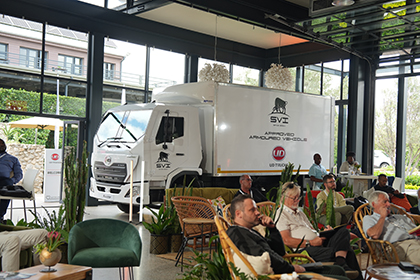 Overall, the new vehicle market registered a sound performance of 9.2%, with aggregate industry sales at 32,169 compared to 29,455 in 2022. UDTS also concluded that 2023 reached over 40% in service agreements.
Overall, the new vehicle market registered a sound performance of 9.2%, with aggregate industry sales at 32,169 compared to 29,455 in 2022. UDTS also concluded that 2023 reached over 40% in service agreements.
This significant progress is a substantial step toward ensuring peace of mind, predictability, and maximising overall uptime for UD Trucks customers.
“What has grown on the heavy-duty side is the pressure to move commodities quickly. The truck industry has taken on some of that responsibility,” says Rory Schulz, Sales Director for UD Trucks Southern Africa. Triggered by the collapse of rail locally, last year UD Trucks sold a whopping 18,458 Heavy-Duty Trucks. UD Trucks also ended the previous year selling 5460 Medium-Duty Trucks and 8251 Light Duty Trucks.
He adds that since the country is now relying on the movement of goods by load, the strong performance of Heavy-Duty Trucks is expected to keep its momentum. But moving commodities plays just a part in UD Trucks SA’s meteoric rise in sales. After-sales service and maintenance contracts also make UDTSA a strong South African truck market competitor.





